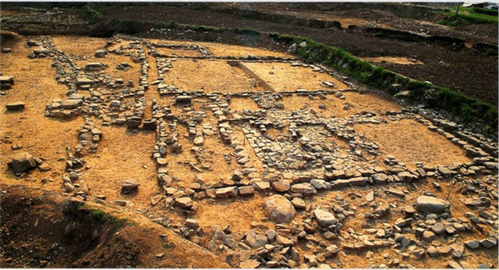"거제 고군현 치소지"의 두 판 사이의 차이
(→영문) |
(→영문) |
||
| 32번째 줄: | 32번째 줄: | ||
===영문=== | ===영문=== | ||
| − | '''Site | + | '''Local Administrative Office Site, Geoje''' |
| − | This site | + | This is presumed to be the site of a local administrative office that was established in the late 7th century and used until the 14th century or later. The site was excavated in 1995 following the discovery of roof tile shards and large stones during the renovation of a nearby rice paddy. |
| − | + | According to a historical record, a local administrative office was established in a place called Sanggun County during the reign of King Munmu (r. 661-681) of the Silla kingdom (57 BCE-935 CE). Roof tiles inscribed with the name Sangsa-ri ("Village in the West of Sang[gun County]") were discovered at this site, as well as at the nearby Dundeokgiseong Fortress (1.5 km to the northwest), suggesting that this area was indeed part of the Sanggun County mentioned in the record. The discovery of the same roof tiles at both sites suggests a close connection between them. | |
| − | + | The structural remains of several buildings were identified during the excavation. The buildings were arranged parallel to one another facing south, following the traditional arrangement of public institutions. This further supports the argument that this is the site of the Silla-period administrative office mentioned in the historical record. Other artifacts discovered here include earthenware from the Unified Silla period (668-935) and earthenware, celadon, and buncheong ware from the Goryeo period (918-1392), attesting to the site's long history. | |
| − | |||
| − | |||
| − | |||
| − | |||
| − | |||
===영문 해설 내용=== | ===영문 해설 내용=== | ||
2022년 9월 13일 (화) 09:53 판
| 거제 고군현 치소지 |
|
| 대표명칭 | 거제 고군현 치소지 |
|---|---|
| 한자 | 巨濟 古都懸 治所址 |
| 주소 | 경상남도 거제시 둔덕면 거림리 285번지 외 |
| 국가유산 종목 | 경상남도 기념물 제162호 |
| 지정(등록)일 | 1997년 1월 30일 |
| 분류 | 유적건조물/유물산포지 유적산포지/유적분포지/유적분포지 |
| 수량/면적 | 28,833㎡ |
| 웹사이트 | 거제 고군현 치소지, 국가문화유산포털, 문화재청. |
해설문
국문
거제 고군현 치소지는 1995년 이곳의 경지를 정리하던 중에 논바닥에서 기와 조각과 큰 돌이 나옴에 따라 공사를 중지하고 발굴 조사를 실시하여 발견된 유적이다. 발굴조사 결과 글자가 새겨진 기와를 비롯하여 신라·고려시대 토기, 고려청자 및 분청사기 등이 주로 출토되었다.
건물지 배치상태가 북쪽에서 남쪽으로 직선상을 이루는 삼국시대 사원의 가람배치나 고려, 조선시대 향교 건물 배치 구조와 동일하다는 점에서 일반 건물이 아닌 관아와 같은 공공의 성격을 가진 건물이 있었음을 추측할 수 있다.
이와 함께 출토된 상사리(裳四里) 기와는 신라 무문왕 때 설치된 상군(裳郡)의 위치가 이곳이었음을 반증해주고 있다.
상사리 기와는 인근의 둔덕기성에서도 발견되어 성곽-행정관청이 세트를 이루었음을 추측할 수 있다.
영문
Local Administrative Office Site, Geoje
This is presumed to be the site of a local administrative office that was established in the late 7th century and used until the 14th century or later. The site was excavated in 1995 following the discovery of roof tile shards and large stones during the renovation of a nearby rice paddy.
According to a historical record, a local administrative office was established in a place called Sanggun County during the reign of King Munmu (r. 661-681) of the Silla kingdom (57 BCE-935 CE). Roof tiles inscribed with the name Sangsa-ri ("Village in the West of Sang[gun County]") were discovered at this site, as well as at the nearby Dundeokgiseong Fortress (1.5 km to the northwest), suggesting that this area was indeed part of the Sanggun County mentioned in the record. The discovery of the same roof tiles at both sites suggests a close connection between them.
The structural remains of several buildings were identified during the excavation. The buildings were arranged parallel to one another facing south, following the traditional arrangement of public institutions. This further supports the argument that this is the site of the Silla-period administrative office mentioned in the historical record. Other artifacts discovered here include earthenware from the Unified Silla period (668-935) and earthenware, celadon, and buncheong ware from the Goryeo period (918-1392), attesting to the site's long history.
영문 해설 내용
이곳은 삼국시대부터 조선 전기에 걸쳐 지어진 각종 건물들이 있던 유적이다.
1995년 이곳의 경지를 정리하던 중에 기와 조각 등이 발견됨에 따라 발굴조사가 실시되었다. 발굴조사를 통해 이곳에 있던 건물들이 남북으로 직선상을 이루고 있었음이 밝혀졌는데, 이는 삼국시대 가람배치나 고려, 조선시대의 향교나 관아의 건물 배치와 유사하다. 따라서 이곳에는 일반 민가가 아닌 관아와 같은 공공의 성격을 가진 건물이 있던 것으로 추정된다.
이곳에서 출토된 유물로는 신라·고려시대 토기, 고려청자, 분청사기 등과 삼국시대 거제 지역의 옛 이름이 새겨진 기와 조각이 있다. 특히 같은 명문이 새겨진 기와가 인근의 둔덕기성에서도 발견되었다. 이는 신라 문무왕(재위 661-681) 때 지금의 거제 지역에 지방 행정관청이 설치되었다는 문헌 기록을 증명하는 자료이며, 성곽과 관아가 짝을 이루고 있었음을 추측할 수 있다.
- 글씨가 새겨진 기와는 이곳에서 1개, 둔덕기성에서 2개 발견되었음.
갤러리
참고자료
- “[거제의 유산(遺産)]상사리(裳四里) 명문 기와 조각”, 거제신문, 2021.02.22. https://www.geojenews.co.kr/news/articleView.html?idxno=63026


